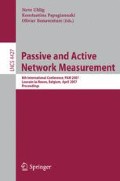Abstract
The use of power control in wireless networks can lead to two conflicting effects. An increase in the transmission power on a link may (i) improve the quality and thus the throughput on that link but, (ii) increase the levels of interference on other links. A decrease in the transmission power can have the opposite effects. Our primary goal in this work is to understand the implications of power control on interference and contention. We conduct experiments on an indoor mesh network. Based on analysis of our experimental data, we identify three interference scenarios: a) the overlapping case, where the aggregate throughput achievable with two overlapping links cannot be improved via power control; b) the hidden terminal case, where proper power control can primarily improve fairness and, c) the potentially disjoint case, where proper power control can enable simultaneous transmissions and thus improve throughput dramatically. We find that power control can significantly improve overall throughput as well as fairness. However, to our surprise, we note that using virtual carrier sensing in conjunction with power control generally degrades performance, often to a large degree.
Access this chapter
Tax calculation will be finalised at checkout
Purchases are for personal use only
Preview
Unable to display preview. Download preview PDF.
References
Akella, A., Judd, G., Seshan, S., Steenkiste, P.: Self-management in chaotic wireless deployments. In: MOBICOM (2005)
ANSI/IEEE802.11-Standard, 1999 edition (1999)
Atheros/AR5006chipset. http://www.atheros.com/pt/ar5006bulletins.htm
Bicket, J.: Bit-rate selection in wireless networks. In: Master’s Thesis, Department of Electrical Engineering and Computer Science, MIT (2005)
Bicket, J., Aguayo, D., Biswas, S., Morris, R.: Architecture and evaluation of an unplanned 802.11b mesh network. In: MOBICOM (2005)
ElBatt, T., Krishnamurthy, S.V., Connors, D., Dao, S.: Power management for throughput enhancement in wireless ad-hoc networks. In: IEEE ICC, IEEE Computer Society Press, Los Alamitos (2000)
Huang, J., Berry, R., Honig, M.: Distributed interference compensation for wireless networks. IEEE JSAC 24(5) (2006)
Kandukuri, S., Boyd, S.: Optimal power control in interference-limited fading wireless channels with outage-probability specifications. IEEE Transactions of Wireless Communications 1(Issue 1), 46–55 (2005)
MadWifi-Driver. http://madwifi.org
Muqattash, A., Krunz, M.: Powmac: A single-channel power-control protocol for throughput enhancement in wireless ad hoc networks. IEEE JSAC 23(5), 1067–1084 (2005)
Nandagopal, T., Kim, T., Gao, X., Bharghavan, V.: Achieving mac layer fairness in wireless packet networks. In: MOBICOM (2000)
NLANR/iperf-version2.0.2. http://dast.nlanr.net/projects/iperf/
Padhye, J., Agarwal, S., Padmanabhan, V.N., Qiu, L., Zill, A., Zill, B.: Estimation of link interference in static multi-hop wireless networks. In: IMC (2005)
Soekris/net4826. http://www.soekris.com/net4826.htm
Son, D., Krishnamachari, B., Heidemann, J.: Experimental study of the effects of transmission power control and blacklisting in wireless sensor networks. In: IEEE SECON, IEEE Computer Society Press, Los Alamitos (2004)
Wattenhofer, R., Li, L., Bahl, P., Wang, Y.-M.: Distributed topology control for power efficient operation in multihop wireless ad hoc networks. In: INFOCOM (2001)
Yang, X., Vaidya, N.: Priority scheduling in wireless ad hoc networks. In: MOBIHOC (2002)
Zhang, H., Arora, A., Sinha, P.: Learn on the fly: Beacon-free link estimation and routing in sensor network backbones. In: IEEE INFOCOM, IEEE Computer Society Press, Los Alamitos (2006)
Author information
Authors and Affiliations
Editor information
Rights and permissions
Copyright information
© 2007 Springer Berlin Heidelberg
About this paper
Cite this paper
Broustis, I., Eriksson, J., Krishnamurthy, S.V., Faloutsos, M. (2007). Implications of Power Control in Wireless Networks: A Quantitative Study. In: Uhlig, S., Papagiannaki, K., Bonaventure, O. (eds) Passive and Active Network Measurement. PAM 2007. Lecture Notes in Computer Science, vol 4427. Springer, Berlin, Heidelberg. https://doi.org/10.1007/978-3-540-71617-4_9
Download citation
DOI: https://doi.org/10.1007/978-3-540-71617-4_9
Publisher Name: Springer, Berlin, Heidelberg
Print ISBN: 978-3-540-71616-7
Online ISBN: 978-3-540-71617-4
eBook Packages: Computer ScienceComputer Science (R0)

